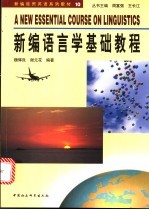图书介绍
新编语言学基础教程pdf电子书版本下载

- 魏辉良,谢元花编著 著
- 出版社: 北京:中国社会科学出版社
- ISBN:7500430868
- 出版时间:2001
- 标注页数:285页
- 文件大小:16MB
- 文件页数:300页
- 主题词:
PDF下载
下载说明
新编语言学基础教程PDF格式电子书版下载
下载的文件为RAR压缩包。需要使用解压软件进行解压得到PDF格式图书。建议使用BT下载工具Free Download Manager进行下载,简称FDM(免费,没有广告,支持多平台)。本站资源全部打包为BT种子。所以需要使用专业的BT下载软件进行下载。如 BitComet qBittorrent uTorrent等BT下载工具。迅雷目前由于本站不是热门资源。不推荐使用!后期资源热门了。安装了迅雷也可以迅雷进行下载!
(文件页数 要大于 标注页数,上中下等多册电子书除外)
注意:本站所有压缩包均有解压码: 点击下载压缩包解压工具
图书目录
1 Language:An Introduction 1
1.1 Properties of language 1
1.1.1 Communicative versus informative 1
1.2.1 Unique properties 2
1.1.2.1 Displacement 2
1.1.2.2 Arbitrariness 3
1.1.2.3 Productivity 4
1.1.2.4 Cultural transmission 5
1.1.2.5 Discreteness 5
1.1.2.6 Duality 6
1.1.3 Other properties 6
1.2 Language functions 7
2 What Is Linguistics? 10
2.1 What is linguistics 10
2.2 What do linguists do? 11
2.2.1 The study of language 11
2.2.2 Application of language study 13
2.3 Some basic distinctions in linguistics 16
2.3.1 Description vs.Prescription 16
2.3.2 Langue and parole 17
2.3.3 Synchrony and diachrony 17
2.3.4 Competence and performance 17
2.3.5 Speech and writing 18
3 Phonetics:The Sound of Language 20
3.1 Representing speech o paper-IPR 22
3.2 The classification of English consonants 24
3.3 Vowels 28
4 Phonology:The Sound Patterns of Language 31
4.1 Phonemes:the phonological units of language 32
4.2 Minimal pairs 32
4.3 Form and meaning 33
4.4 Distinctive features 34
4.5 Sequence constraints 34
4.6 Phones and allophones 36
4.7 Phonological process rules 38
4.7.1 Assimilation rules 38
4.7.2 Dissimilation rules 39
4.8 Suprasegmental features 41
4.8.1 Stress 41
4.8.2 Pitch 44
4.8.3 Intonation 44
5 Morphonogy:The Words of Language 47
5.1 Open and closed classes of words 48
5.2 Word sets 49
5.3 Morphemes:the minimal units of meaning 50
5.4 Allomorphs 54
5.4.1 Phonological conditioning of allomorphs 54
5.4.2 Morphological conditioning of allomorphs 54
5.5.1 Morphological rules of word formation 55
5.5 English word formation 55
5.5.1.1 Derivation 56
5.5.2 English word formation 56
5.5.1.1.1 Prefixation 57
5.5.1.1.2 Suffixaion 59
5.5.1.2 Compounding 59
5.5.1.3 Conversion 60
5.5.1.4 Acronyms 63
5.5.1.5 Clipping 63
5.5.1.6 Blending 64
5.5.1.7 Back-formation 64
5.5.1.8 Reduplication 64
6.1 Traditional grammatical concepts 66
6 Syntax:Traditional Grammar 66
6.1.1 The parts of speech 67
6.1.2 Some other traditional categories 67
6.1.3 Traditional analysis 68
6.1.3.1 Appropriateness 68
6.1.3.2 The prescriptive approach 69
6.1.3.3 Sentence,clause and phrase 71
7 Structural Grammar 79
7.1 Discovery procedure 79
7.2 Phoneme and morpheme 80
7.3 Word class 81
7.3.1 Nouns 82
7.3.2 Verbs 83
7.3.3 Adjectives and adverbs 83
7.4 Function word 84
7.5 Sentence formulas 86
7.6 Immediate constituent analysis 86
8 Transformational-Generative Grammar 93
8.1 Transformation 93
8.2 Generation 101
8.3 Rules 105
9 Semantics:The Meaning of Language 111
9.1 Semantic properties 111
9.2 Ambiguity 114
9.3 Metaphor 116
9.4 Paraphrase 118
9.5 Antonyms:different sounds,opposite meanings 121
9.6 Anomaly:no sense and nonsense 122
9.7 Idioms 125
9.8 The ‘truth’of sentences 126
9.9 Sense and reference 128
10 Pragmatics 130
10.1 What is pragmatics? 130
10.2 Deixis and distance 131
10.2.1 Person dexis 131
10.2.2 Spatial Deixis 132
10.2.3 Temporal deixis 134
10.3 Context 135
10.4 Reference and inference 135
10.5 Presupposition 137
10.6 Speech acts 137
10.6.1 Three dimensions of speech acts 138
10.6.2 IFID 139
10.6.3 Felicity conditions 140
10.6.4 Speech act classification 140
10.6.5 Direct and indirect speech acts 142
10.7 Politeness 143
11.1 Interpreting discourse 146
11 Discourse Analysis 146
11.2 Cohesion 147
11.3 Coherence 148
11.4 Speech events 149
11.4.1 Conversational interaction 149
11.4.2 The co-operative principle 150
11.5 Background knowledge 151
12 Languages and Writing 155
12.1 Ideographic writing 155
12.2 Pictographic writing 158
12.3 Syllabic writing,unlimited and limited 160
12.4 Alphabetic writing 161
12.5 The wanderings of the alphabet 164
13 Language History and Change 170
13.1 Family trees 170
13.3 Cognates 171
13.2 Family relationships 172
13.4 Comparative reconstruction 172
13.5 Language change 174
13.5.1 Old English 175
13.5.2 Middle English 176
13.5.3 Sound changes 176
13.5.4 Syntactic changes 178
13.5.5 Lexical Changes 178
13.6 The process of change 179
14 Language and Society 180
14.1 What is sociolinguistics? 180
14.2 Relationships between language and society 181
14.3 Some basic methodological concerns 182
14.4 Social dialects 184
15.2 Language and dialects 184
14.4.1 Social class 185
14.4.2 Age and gender 186
14.4.3 Ethnic background 189
14.4.4 Idiolect 189
14.4.5 Style,register and jargon 190
14.4.6 Diglossia 191
15 Language Varieties 193
15.1 What is variety? 193
15.3 Accent and dialect 200
15.4 Regional dialects 201
15.5 Bilingualism 203
15.6 Pidgins and creoles 203
15.7 Language planning 206
16 Language and Culture 209
16.1 What is culture? 209
16.2 Linguistic determinism 210
16.3 The Sapir-Whorf hypothesis 211
16.4 Kinship system 214
16.5 Color-terms 216
16.6 Prototype theory 218
16.7 Taboo and euphemism 219
17 First Language Acquisition 224
17.1 Theories of first language acquisition 224
17.1.1 Behavioristic approaches 225
17.1.2 The nativist approach 227
17.1.3 Functional approaches 230
17.2 Issues in child language acquisition 232
17.2.1 Competence and performance 232
17.2.2 Comprehension and production 234
17.2.3 Nature or nurture? 234
17.2.4 Universals 235
17.2.5 Systematicity and variability 236
17.2.6 Language and thought 236
17.2.7 Imitation 237
17.2.8 Practice 238
17.2.9 Input 239
17.2.10 Discourse 240
18 Theories of Second Language Acquisition 242
18.1 Hypotheses and models 242
18.1.1 Krashen s Input Hypothesis 244
18.1.2 Mclaughlin s Attention-processing 246
18.1.3 Bialystok s Analysis/Automaticity Model 248
18.1.4 Variability models 250
18.1.5 The Believing and Doubting Games 251
18.2 From theory to practice 252
Appendix Corpus Linguistics 255
Definition of corpus 256
Definition of corpus linguistics 257
The early stage of corpus linguistics-historical conspectus 258
The second stage-the beginning modern corpus linguistics 261
The third stage-thd resurgence of corpus linguistics 265
Issues in corpus design and compilation 270
Corpus Annotation 275
References 282